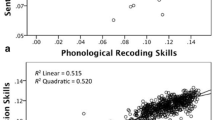Abstract
Recent research indicates that a major cause of reading (decoding) disabilities lies in an inability to manipulate speech at its phonemic (phonological) level. The Auditory Discrimination in Depth Program (ADD Program), stimulates basic phonological awareness and has been used extensively at The Reading Foundation in Calgary, Alberta. Here we present pre- and post-test data from 281 clients (ranging from school-age through adulthood) seen over a two-year period; post-test data was collected after 80 hours of ADD instruction. To assess whether significant gains had been achieved, an analysis of covariance was performed, covarying for age and initial vocabulary scores. After 80 hours of intensive instruction, highly significant gains (p<.001) were evident on measures of phonological awareness, sound/symbol connections, word identification, spelling, and decoding in context. In addition to the treatment effect, age and vocabulary had some influence on some of the variables. The data was also analyzed to determine whether the results went beyond a “group effect” only. A total of 229 cases were tabulated for gains or losses on the word attack subtest and on the reading and spelling subtests of the WRAT-R. Results indicate that the remediation was effective for all subjects, though gains on spelling tended to be less than on the two reading scores.
Similar content being viewed by others
References
Adams, M. J. 1990.Beginning To Read. Cambridge: The MIT Press.
Alexander, A. W., Andersen, H. G., Heilman, P. C., Voeller, K. K. S., and Torgeson, J. K. 1991. Phonological awareness training and remediation of analytic decoding deficits in a group of severe dyslexics.Annals of Dyslexia 41:193–206.
Ball, E. W., and Blachman, B. A. 1988. Phoneme segmentation training: Effect on reading readiness.Annals of Dyslexia 38:208–25.
Bell, N. 1991a. Gestalt imagery: A critical factor in language comprehension.Annals of Dyslexia 41:246–60.
Bell, N. 1991b.Visualizing and Verbalizing for Language Comprehension and Thinking. Paso Robles: Academy of Reading Publications.
Blachman, B. 1991. Early intervention for children’s reading problems: Clinical applications of the research in phonological awareness.Topics in Language Disorders 12:51–65.
Bradley, L. 1987. Categorising sounds, early intervention and learning to read: A follow-up study. Paper presented at the British Psychological Society London Conference, December, 1987.
Bradley, L., and Bryant, P. E. 1983. Categorising sounds and learning to read—a causal connection.Nature 30:419–21.
Bradley, L., and Bryant, P. 1985.Rhyme and Reason in Reading and Spelling. Ann Arbor: University of Michigan Press.
Byrne, B., Freebody, P., and Gates, A. 1992. Longitudinal data on the relations of word-reading strategies to comprehension, reading time, and phonemic awareness.Reading Research Quarterly 27, 2:140–51.
Dunn, L. M., and Dunn, L. M. 1981.Peabody Picture Vocabulary Test-Revised. Circle Pines, MN: American Guidance Service.
Gray, W. S. 1963.The Gray Oral Reading Test. Indianapolis, IN: The Bobbs-Merrill Company, Inc.
Jastak, S., and Wilkinson, G. S. 1984.The Wide Range Achievement Test-Revised. Wilmington, DE: Jastak Associates, Inc.
Lindamood, C. H., and Lindamood, P. C. 1979.Lindamood Auditory Conceptualization Test. Allen, TX: DLM Teaching Resources.
Lindamood, C. H., and Lindamood, P. C. 1975.Auditory Discrimination in Depth. Allen, TX: DLM Teaching Resources.
Lovett, M. W. 1991. Reading, writing, and remediation; Perspectives on the dyslexic learning disability from remedial outcome data.Learning and Individual Differences 3:295–305.
Lundberg, I., Frost, J., and Peterson, O. 1988. Effects of an extensive program for stimulating phonological awareness in preschool children.Reading Research Quarterly 23:263–84.
Rosner, J. 1990.Helping Children Overcome Learning Difficulties (2nd. ed.) Novato, CA: Academic Therapy Publications.
Spear-Swerling, L., and Sternberg, R. J. 1994. The road not taken: An integrative theoretical model of reading disability.Journal of Learning Disabilities 27, 2:91–103, 122.
Torgesen, J. K., and Morgan, S. 1990. The effects of two types of phonological awareness training on word learning in kindergarten children. Manuscript submitted for publication, Florida State University, Tallahassee, FL.
Truch, S. 1990.The Missing Parts of Whole Language. Calgary: Foothills Educational Materials.
Wechsler, D. 1991.Wechsler Intelligence Scale for Children-Third Edition. San Antonio, TX: The Psychological Corporation.
Wechsler, D. 1981.Wechsler Adult Intelligence Scale-Revised. San Antonio, TX: The Psychological Corporation.
Wechsler, D. 1974.Wechsler Intelligence Scale for Children-Revised. New York: The Psychological Corporation.
Woodcock, R. W. 1973.Woodcock Reading Mastery Tests. Circle Pines, MN: American Guidance Service.
Author information
Authors and Affiliations
Rights and permissions
About this article
Cite this article
Truch, S. Stimulating basic reading processes using auditory discrimination in depth. Annals of Dyslexia 44, 60–80 (1994). https://doi.org/10.1007/BF02648155
Issue Date:
DOI: https://doi.org/10.1007/BF02648155




